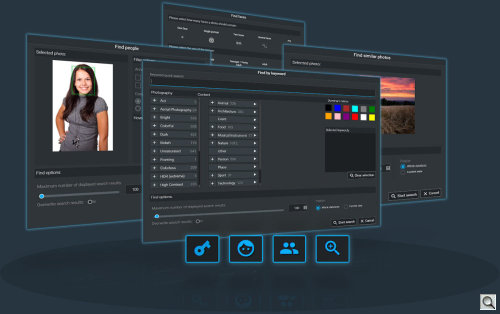Photo Corners headlinesarchivemikepasini.com
![]()
A S C R A P B O O K O F S O L U T I O N S F O R T H E P H O T O G R A P H E R
![]()
Enhancing the enjoyment of taking pictures with news that matters, features that entertain and images that delight. Published frequently.
Road Test: Excire Foto



4 July 2020
You are banished to a tropical island (complete with deadly mosquitoes) and can take with you either an electrician or a plumber. Which do you choose? (Careful, your life depends on it.)
That pretty much sums up the dilemma of the contingent that wants Lightroom's editing and cataloging chops but not its subscription plan. They can go with the image editing practitioners that promise a cataloging module Real Soon Now or they can, well, no cataloging option offers image editing.
But hang on a second.
Excire, which delivered a quite useful if not infallible intelligent search plug-in for Lightroom, has developed a standalone cataloging application that incorporates its smart search engine. And it turns out it's got an attractive interface and is a pleasure to use.
They call it Excire Foto.
We've been testing it since the European release early in June. Today the company has announced the launch of the U.S. version. Here's our report.
DAM SOFTWARE
Software that builds a catalog of your image collection is the genre to which Excire Foto belongs. We call this asset management software, among which Canto Cumulus, Extensis Portfolio, QPict were all early offerings.
Asset management software creates a database of your image collection that includes where the images are stored, what they look like (as thumbnails) and various other essential information some of which is gleaned from the image's Exif header (like creation date or exposure information) and others you can add (like ratings or keywords).
Like any database software, it includes retrieval methods or ways to view the data it collects through various filters. That includes searching for specific images.
It is not just an image browser like Adobe Bridge or Photo Mechanic, although it must, of course, provide browsing functions. And it does not necessarily include ingesting functions to move your images off your camera to more permanent storage, although it may include that, too.
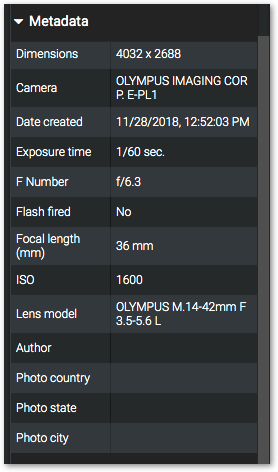
Metadata. Metadata is at the heart of digital asset management and Excire Foto easily mines it.
It also does not include image editing options, although image rotation is often included. But it must render Raw data so an image from it can be seen.
EXCIRE FOTO & DAM
While Excire Foto can copy images from an SD card, it does not include a more powerful ingesting function that can add metadata like copyright to your images during import. Nor does it offer any image editing functions other than rotating an image's orientation.
The database it builds leaves your images where you put them and provides an image browser to review thumbnails of them.
When browsing your collection, you can rate individual images and add keywords and color labels.
But the unique strength of Excire Foto is that it has been trained on millions of images to recognize what's in your photos, including objects and people. This gives it special powers for retrieving a selection of images.
The company has said future versions may include some form of image editing as well, but this release does not.
SYSTEM REQUIREMENTS
We installed Excire Foto on a 10-year-old MacBook Pro running 10.13.6 with 16-GB RAM, which is a bit underpowered, according to the specs. But it did run and it ran just fine.
The official system requirements are:
- Multi-core processor with 64-bit support
- macOS 10.14 (or higher) or Windows 10 (64bit)
- 8-GB RAM, but 16-GB RAM or more is recommended
For 1,000 photos Excire Foto requires around 250-MB of storage. The corresponding preview cache is about 25-GB if you chose the highest quality and you create previews for all photos.
INSTALLATION, REGISTRATION
For macOS, both an installer and uninstaller script is included with the disk image. For Windows an executable file is distributed.
After installing on either system and launching the program, a Welcome screen offers the option to buy the software, enter a license key or run the trial version for 30 days.
We ran the trial for a few days and subsequently entered a license key without incident. We also subsequently installed an update without disturbing either our active database or license, just as you would expect.
A TOUR
There are two main views of your image collection and a full screen mode in Excire Foto:
In Gallery View, thumbnails are displayed in the main window with a toolbar for ratings, colors, flags, metadata and date. You can also add more photos to the database, filter the collection, search for images and collapse the right panel for more gallery viewing space.
In Preview View, the selected photo is displayed in the main window with a toolbar for ratings, colors, flags and more. The collapsible right bar contains information about the file name, the histogram, the keywords section, the keyword hierarchy and the metadata section. You can add keywords to the image, as well.
There's a lot more going on in each view, of course, but the two views should be familiar to anyone who has worked with Lightroom's Library module or Photo Mechanic.
You're either looking at a collection of thumbnails or a single image.
This mode allows you to zoom in or out of the image using either the mouse wheel or trackpad. Left and right navigates to the next or previous image. Stars, colors and flags can also be assigned.
PREFERENCES
Excire Foto offers six panels of preference settings to customize the behavior of the program to your needs.

- General. You can instruct Excire Foto to use all of your CPU's cores to analyze your images. You can also choose whether to focus analysis on content or color. Language settings are also available here as is the font size of the user interface.
- Collections. You can set the size of the preview cache and clear it, set the photo compression for quality, and tell Excire Foto to ignore hidden folders and files.
- Metadata. You can direct Excire Foto to always use sidecar files rather than write metadata to the Raw file of JPEGs. You can tell the program to harvest existing keywords from the images themselves or a sidecar file. And you can indicate which metadata you want to use as filters in Gallery View.
- Labels. Five color labels are available: Red, Yellow, Green, Blue and Purple with corresponding designations you can assign here.
- Sharing. You can choose to share the thumbnail, embedded JPEG or original image. You can also connect to either Dropbox or Google Drive.
- License. This panel contains your licensing information.
We particularly like the option to use all of our CPUs cores, which is no small task but a big win in efficiency. And we're glad to see you can dump metadata to a sidecar file because, if you edit large images frequently, you'll save time backing up your system if only the small sidecar files are changed.
GETTING STARTED
The party gets started when you select
Addin the Folders panel on the left side.
Add Folders. You'll want to let large collections run overnight but a shoot was pretty quickly added on our old system.
That presents three options:
- Include subfolders
- Analyze photos
- Always create previews
If your folder structure includes subfolders with images, you'll want to include them. If you want Excire Foto to analyze your images, comparing them to a list of keywords, this is a good time to enable that option. And if you want to work on the catalog without access to the original image, you'll want to create previews.
Previews are 1280 pixels on the long edge and always created for Raw files, which otherwise would not display an image. The previews are stored on your hard disk.
AI FUNCTIONS
Once the catalog has been built, you can tap into Excire Foto's artificial intelligence to browse your image collection. You can access these functions from the AI bar, icons in individual photos or using the
Findmenu item.The options include:
- Find by Keyword. Search by keyword (either Excire's hierarchical list of things it knows about or your own flat list of keywords) shown on the screen. You can also set a dominant color. For example, we searched for
VehiclesandCarand then selected theRedpatch to look for a red car. The search returned several, including one that was a scan of a color negative.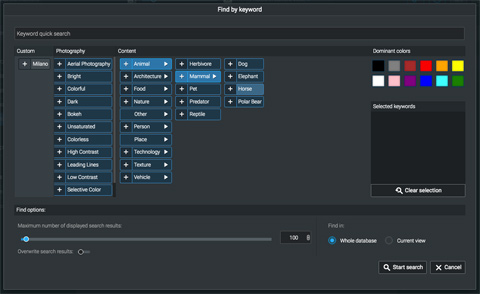
Find by Keyword. We're looking for a pet horse using Excire's built-in hierarchical keywords.
- Find Faces. Search images of people that include one face, two faces, several faces, any faces or a single portrait. You can also restrict the search to the age of the person from baby/toddler to child to teen/young adult to adult to elderly. Finally you can select gender and smile attributes.
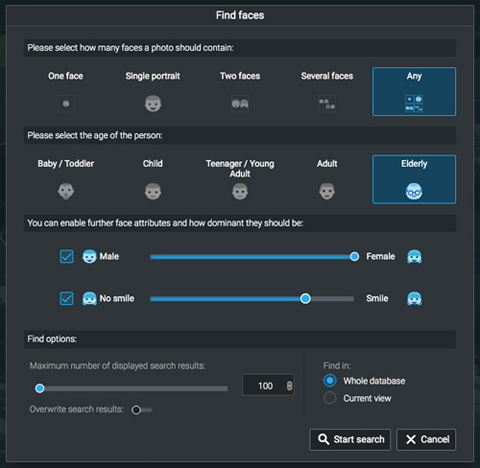
Find Faces. Here we've asked Excire Foto to find elderly women who might be smiling.
- Find People. Search images of people who are smiling or not with eyes open or closed. The people can be any selected person of one of the selected people.
- Find Similar Photos. Set the maximum number of photos to find, whether to overwrite previous search results and whether to search the whole Excire Foto database or just the current view.
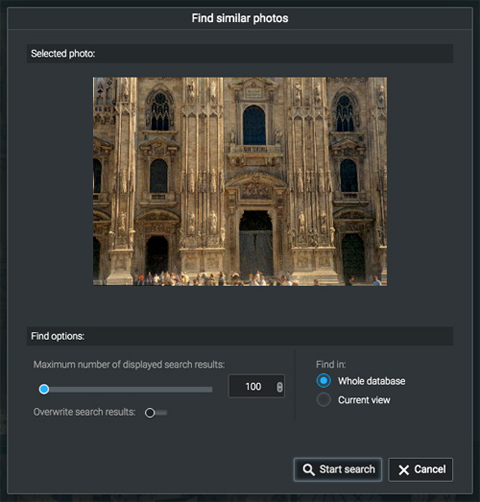
Find Similar. The selected photo is the base.
COLLECTIONS
Excire Foto defines two kinds of Collections. One contains the images found by a search. The other contains a manually-refined selection of images.
Result Collections can be any of several types:
- Last Search Results
- Find Similar Photos Results
- Find by Keyword Results
- Find Faces Results
- Find People Results
Custom Collections can start as a Result Collection that you refine by deleting or adding to the collection manually.
Both kinds of collections can be exported and shared.
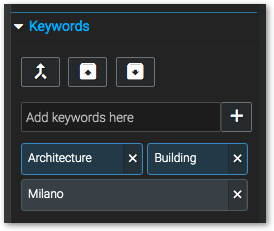
Keywords. Excire's keywords are in blue. Our own are in gray.
KEYWORDS
Excire Foto's built-in keywords are organized in a hierarchy. You can join, copy and paste keywords. You can define your own keywords apart from the Excire Foto keywords but you can't organize your own keywords in a hierarchy.
MISCELLANEOUS
To facilitate editing images, Excire Foto includes an
Open Withcommand to load the file in the image editing software of your choice. You may reference more than one of these, as well.Excire recommends saving the edited file with a suffix to the base name so it appears next to the original in the catalog. If
MRP1234.nefwas saved asMRP1234.r.jpg, the JPEG edit would appear next to the Raw file.Those two files can be merged into a stack when the folder is synchronized.
USING EXCIRE FOTO
Integrating a digital asset management program into your workflow can be done in several ways. Excire Foto's strength is its analysis of your image content using artificial intelligence. So the question is where in the production workflow that would come in handy.
You could, for example, use Excire Foto's artificial intelligence to simply assign keywords to your images that would be stored in the Exif header of the image file or a sidecar file. The keywords would be searchable by macOS or Windows or other imaging programs.
You could take that a step further and use Excire Foto to also browse your images for rating and culling. Excire Foto can automatically identify images of people with their eyes closed, for example, so you don't have to manually weed them out.
That approach syncs well with other image editing applications where you can use Excire Foto to narrow down a shoot to the images you want to work with, exporting them as a collection that can be imported in the other application.
The one exception to this might be Lightroom because Excire already offers Excire Search, a smart search plug-in for Lightroom.
And clearly, Excire Foto can function as home base for the digital asset management of your image collection. As a hub, you can send images out to an image editing app for editing and add the edit to the collection.
Excire has tested Excire Foto with Adobe Camera Raw, Adobe Photoshop, Adobe Lightroom Classic, Phase One Capture One, DxO Photolab, Affinity Photo and Skylum Luminar 4.
We did rub up against a few rough edges.
We couldn't find the About box, which is usually on the menu bar under the application name. But we found it under the Help menu. We wanted to know the version number. We had originally installed v1.0.0 and later updated to v1.0.5.
More seriously, Excire Foto doesn't show all the filenames in the Gallery View, just the selected image. The filename appears at the top of the right side panel.
But where is that file? To find out, you hover over the filename and a tooltip reveals the location. That same trick works for finding the full path of the folders added to the database that are listed in the left panel.
We couldn't find the location of the default database, though. You can set the location, but the default location does not seem to be disclosed.
We were able to backup our current database even though we didn't know where it was. It took about five seconds to backup our test database of 355 images. that backup, which includes the 1280-pixel previews and thumbnails used 224-MB of disk space.
Then we had a bright idea.
We pointed Excire Foto to a new directory for our databases. It restarted showing nothing in the database in the new directory. So we quit the application and copied the files in our backup folder to the new directory. When we restarted Excire Foto, we had both restored our database and knew where it was.
QUESTIONS, ANSWERS
With such a new product, it's worthwhile to look over a few of the most frequently asked questions.
What image file formats does Excire Foto support?
Exire Foto supports .
3fr, .arw, .cr2, .cr3 (only Mac and with macOS 10.15), .crw, .dcr, .dng, .erf, .gpr, .iiq, .kdc, .mef, .mos, .mrw, .nef, .nrw, .orf, .pef, .ppm, . raf, .Raw, .rw2, .sr2, .srf, .srw, .x3f, .bmp, .jpg, .jpeg, .jpe, .jfif, .png, .pgm, .tif, .tiffSome compressed variants of these formats are not supported.
What further developments are planned for Excire Foto?
Excire Foto will be updated to improve the AI and add functions that support the management and selection of photos. There are also plans for basic functions for image editing and enhancement.
Can I train the Excire AI myself?
No. Excire Foto has been trained with several million photos on special hardware. All this is done in an elaborate offline process that takes several days and represents a compromise between best recognition performance and minimum runtime to function efficiently on personal computers.
Where can I get help?
Visit the Excire Foto forum or email tech support at support@excire.com.
Will my photos be loaded into a cloud for analysis?
No. Excire respects your privacy. Analysis of your photos is done on your computer.
PRICE, AVAILABILITY
Excire Foto is available now for macOS 10.14+ and Windows 10 (64-bit) in the Excire online shop at an introductory price of $39 (regularly $59). A fully functioning 30-day trial version is also available for download from the Excire Web site.
CONCLUSION
We've been using (and frankly relying on) the Excire Search plug-in for Lightroom since it was released. We really appreciate having artificial intelligence comb through our collection of over 68,000 images.
And while we've made it clear the results are not infallible, we should also point out that with a hierarchical keyword system, all you have to do is hit the target, not a bullseye. So if you tag an image as architecture but can't tell if it's a church or a stadium, you still get points.
If you're moving from Lightroom to Capture One or Affinity Photo and miss the cataloging functions in the Adobe product, Excire Foto provides a compelling solution.
Standalone cataloging with artificial intelligence for $39? Start the fireworks.
But there's more.
We've been impressed with the elegance of the design of Excire Foto. It's user interface is accessible, avoiding confusing and putting the tools you need at your fingertips. We didn't even mention either the contextual menus or the Menu bar in this overview because almost everything you need is right there on the screen.
That user interface is just another example of how well thought-out Excire's products are. Intelligent, you might say.
So we're awarding even this early version all four corners.
Powerful Excire Foto Now Available in the United States AI-based photo management software organizes photo collections and offers fast content-based browsing
NOKOMIS, Fla. -- In today's digital photo world nearly everyone takes more pictures than ever before. But photographers trying to locate a specific image of theirs or even a group of images, which share similar visual characteristics, can easily lose track of the resulting flood of images. This is where AI (Artificial Intelligence) can help. With Excire Foto, AI-experts from Germany have developed a software product with many intelligent functions to help users organize their image collections and find the photos they need.
Using modern image and face recognition techniques, Excire Foto automatically analyzes and tags the photos in a user's collection, with keywords. Whether the photos are from a beach vacation or a family celebration, Excire Foto AI finds the photos in a flash and brings the otherwise hidden photo-treasures to light.
"This way, even a large collection of photos finally can feel like the familiar old shoebox in which many generations of photographers had their photos at hand and ready to show their families and friends alike," said Erhardt Barth, Founder and President of Excire.
Then, via the user's Dropbox or Google Drive, the found pictures can be easily shared online. Additionally, the images' keywords can be exported and used elsewhere. Thus, using Excire Foto saves time that allows users to focus on the creative side of their photography.
Companies such as Google, Apple and Adobe also offer solutions that support finding images. However, to do so, a user has to upload their images to their cloud, with the corresponding risks. Excire Foto works locally on the user's computer.
Excire Foto is available now for macOS (version 10.14 or newer) and Windows 10 (64-bit) in the Excire online shop at an introductory price of $39. The regular price is $59. A fully functioning 30-day trial version is now available for free download from the Excire Web site.
Watch the following YouTube video for additional information and a demo of the new Excire Foto: https://youtu.be/TZRDm6LFgiQ
